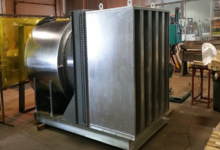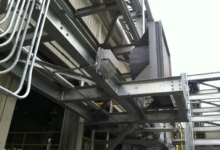“There’s nothing standard about our noise business.”
A chemicals manufacturer in Georgia approached SysTech Design to implement a plan to attenuate elevated noise levels at the plant’s property line. When remote manufacturing plants are slowly surrounded by residential housing construction, community noise becomes a sensitive issue, and local noise codes are often violated.
Analyzing Plant Noise Sources
Combined noise sources from a manufacturing facility require careful field analyses to determine which specific noise sources need to be addressed and in what priority they need to be corrected to meet code.
Systech Design, along with a noise consultant, evaluated plant noise sources from mechanical equipment, and pin pointed a 24,000 CFM Fanex air cooled heat exchanger assembly as a “key” offender.
Field measured noise levels of the Fanex unit were recorded as 98 dBA at 3 feet. To meet the code requirements, the modified heat exchanger needed to have an attenuated noise level of 82 dBA at 3 feet. When silencing fan noise, any modifications made to quiet the unit must result in minimal change to the pressure drop through the fan. In this case, the design airflow was critical to the process. The client indicated to Systech that being able to design, test and implement the fan silencers in a timely fashion was critical, as the heat exchanger was a crucial part of their process and only one spare unit was available. Systech had the customer’s spare heat exchanger shipped to their facility to analyze the unit’s noise level in their acoustical test chamber.
After running a series of acoustical tests on the heat exchanger, SysTech’s engineers were able to come up with a dual silencer design (inlet and discharge fan silencers). The design resulted in minimal pressure drop, and after addition of the silencers, the heat exchanger’s attenuated noise level measured less than 80 dBA at 3 feet while still maintaining design airflow levels.
Fan Silencer Design
SysTech’s acoustical engineers proposed custom built inlet and discharge silencers for the heat exchanger.
The 60” x 52” circular inlet silencer was constructed of 16-gauge sheet metal casing with a 22 gauge galvanized perforated liner, packed with acoustic media under compression. An internal layer of fiberglass cloth was also included to prevent media erosion, which can occur over time. The inlet silencer resulted in a 15 dBA reduction to the inlet side of the unit and added minimal pressure drop, 0.07” wg. at 24,000 CFM.
The 65.5” x 65.5” rectangular discharge silencer was constructed of a 14-gauge galvanized steel casing with internal 22 gauge galvanized perforated baffles, packed with acoustic media under compression. The silencer was equipped with a custom built viewport to give maintenance personnel quick access to the coil for inspection. The discharge silencer resulted in a 15 dBA reduction to its respective side of the unit and the pressure drop through the silencer was negligible, 0.1” wg. at 24,000 CFM.
The final heat exchanger and dual silencer assembly weighed 2,300 pounds; all mounted on a unitary base with built in lifting eyes to facilitate re-installation.
Factory Acoustic Analysis
After mounting the silencers to the heat exchanger, Systech again tested the unit to confirm the attenuated noise levels met the design criteria. Systech was able to confirm that the acoustically modified heat exchanger’s noise level had exceeded the customer’s requirement. The adapted heat exchanger measured less than 82 dBA at 3 feet from all four sides.
Systech was able to test, engineer, fabricate and install the custom built silencers and ship them back to the customer in a four-week time span. We look forward to exceeding your expectations. Call SysTech at 800-456-9460 to learn more about how we can alleviate noise issues within or adjacent to your facility.




